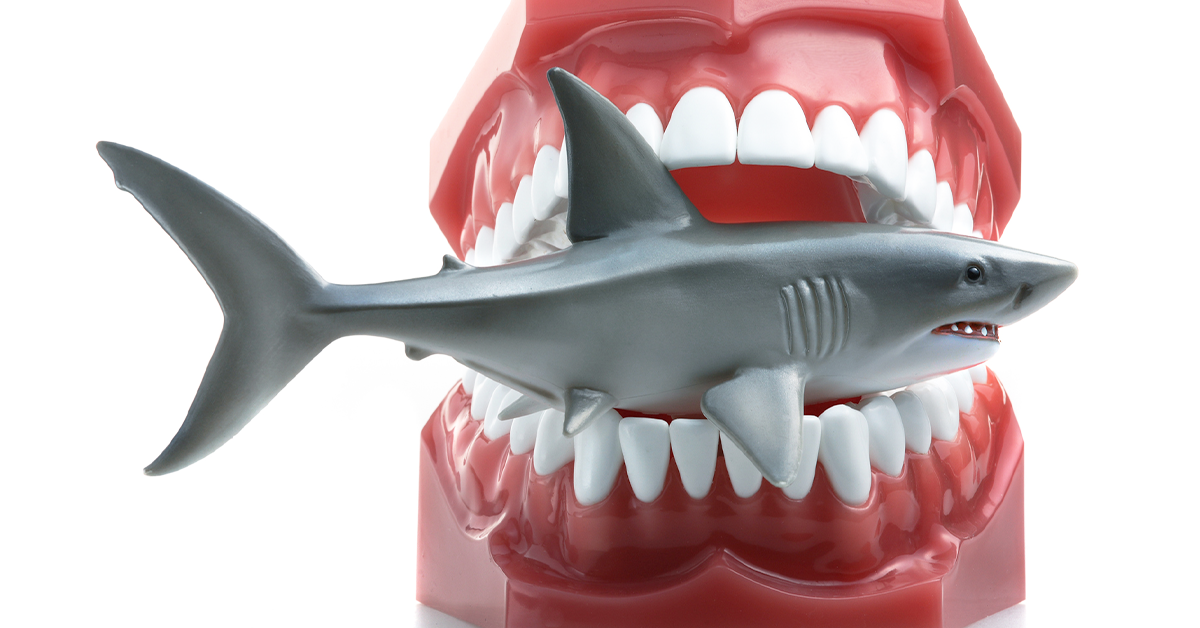Every year, Shark Week dives into the mysterious world of the oceans most iconic predators (while also giving us the cliché entertainment that’s hard to resist, like re-runs of Jaws and crazy swimming with shark moments). But beyond the thrill of the classic movies and dramatic deep-sea facts comes something surprisingly relevant to dentistry: shark teeth!
Sharks can lose and replace thousands of teeth in a lifetime — some even shedding one tooth per day. While humans don’t have that luxury (and quite frankly probably aren’t interested in the idea of losing teeth that often), the concept of natural tooth turnover that’s so important in shark anatomy has inspired innovation in restorative dentistry.
Sharks secret weapon
Unlike humans, sharks get an endless set of teeth. They have multiple rows of teeth that function like a conveyor belt, meaning as a tooth is lost or worn down, a new one from the next row replaces it. This process can occur quickly and often, with some species shedding up to 30,000 teeth in a lifespan. While the structure of shark teeth vs. human teeth might have similarities, this process does not. And tooth loss in humans affects more than just a smile — it impacts daily functions like chewing, speech and bone density.
Regrowing teeth like sharks is definitely out of the question for humans, but that doesn’t mean the concept can’t be used to explore advanced options for the future. Many researchers study the fascinating way sharks can restore teeth in hopes of translating it into human restorative dentistry. Here are a few ways the dental field has collaborated with biology to catch up and make strides in helping patients reclaim their natural smile.
Dental implants: The modern-day replacement option
Artificial tooth roots (typically made out of titanium) have allowed dentists to provide the closest option to humans that sharks have in terms of tooth replacement. While it’s more strenuous on the body (and wallet) than naturally losing and re-growing a tooth as many times as needed, it is an option designed to last decades with proper care, surely outlasting some shark teeth that fall out daily!
Creating the look: Crowns, bridges and veneers
Sharks may beat humans in the natural restoration process, but modern dentistry has learned another thing from shark teeth — they aren’t pretty. A world where humans have the same looking teeth as shark feels straight out of a horror movie. Current restorative dentistry may not be possible as easily as sharks have it, but it does come with the ability to restore shape, size and color of damaged or replaced teeth. There might be something to be said about a more intense tooth replacement process for a clean, beautiful and functioning looking and feeling tooth.
Emerging innovations
- “Shark tooth” inspired dental materials: Researchers are investigating the unique structure of shark enamaloid (known for its hardness and stiffness) to aid in developing new dental materials for fillings and crowns/implants that mimics the resilience of shark teeth.
- Shark skin anti-bacterial micropatterns: Sharks are known for their unique skin that can resist bacterial adhesions. This knowledge is continuously advancing the creation of antimicrobial surfaces for dental appliances, like braces, expanders and dentures.
The bottom line: Sharks may not worry about booking appointments or having insurance, but their natural tooth restoration process is contributing heavily to dental advancements. It might not ever be fully possible in humans, but it does provide real-time research and an inspiration for restorative dentistry.

